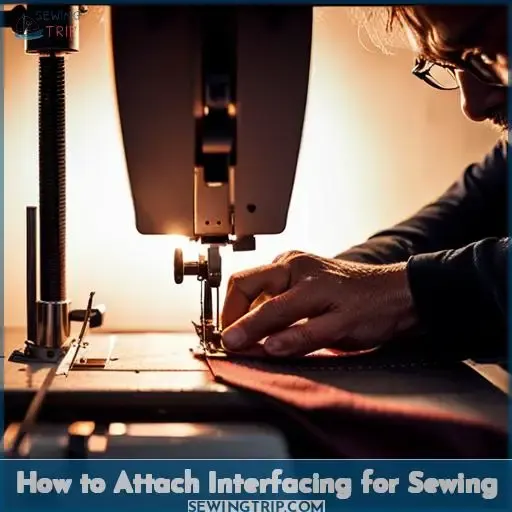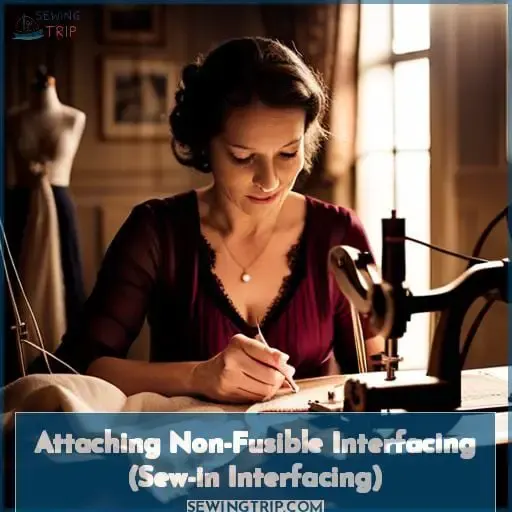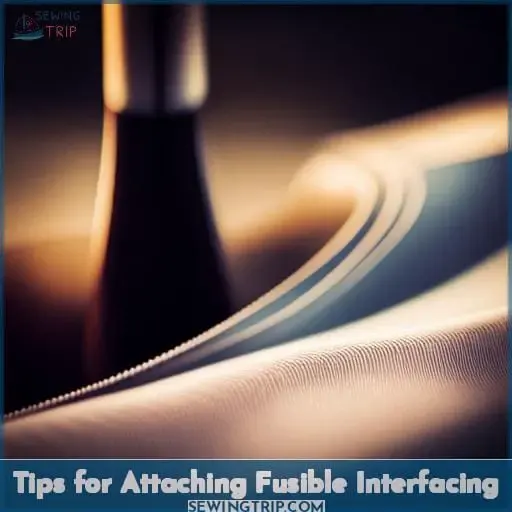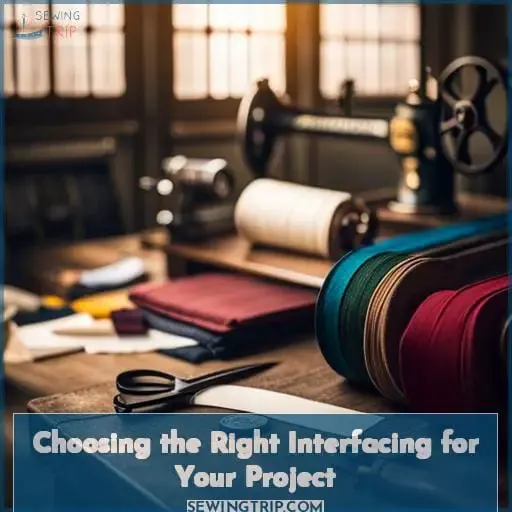This site is supported by our readers. We may earn a commission, at no cost to you, if you purchase through links.
 Ready to give your sewing projects a professional touch? Interfacings are the answer! Whether you’re looking for structure, stability or just an extra special finish, there are types of interfacing out there that can help.
Ready to give your sewing projects a professional touch? Interfacings are the answer! Whether you’re looking for structure, stability or just an extra special finish, there are types of interfacing out there that can help.
In this article we’ll discuss how to attach both non-fusible and fusible interfacings so you can get great results every time. We’ll also go over some tips on choosing the right one for your project and achieving that perfect finish with interfacing.
Table Of Contents
Key Takeaways
- Interfacing enhances sewing projects for a professional finish.
- Select the right interfacing type based on your project’s needs and fabric variety.
- Attach interfacing by pinning it to the fabric’s wrong side then stitching with a slightly shorter seam allowance.
- Utilize fusible interfacing for its easy application and follow proper techniques to attach it.
Attaching Non-Fusible Interfacing (Sew-in Interfacing)
When attaching non-fusible interfacing, start by cutting out the pattern pieces from both the fashion fabric and interfacing, matching them up raw edge to raw edge. Pin the interfacing to the wrong side of the fabric with just a few pins to avoid distortion.
Then stitch the two together using a slightly shorter seam allowance for the interfacing. Trim away any excess close to the stitching before repeating this process for any other matching fabric pieces.
Cutting Out Pattern Pieces
Once you’ve got your pattern pieces cut out, you’re ready to add structure with some sew-in interfacing – interfacing can improve a garment’s durability by up to 40%. Carefully cut out your fabric pieces according to the pattern guidelines first. Then use those cut pieces to trace and cut the interfacing to precisely match each fabric shape.
Take care to cut along the grainline and lay out interfacing pieces as you did the fabric. With pattern pieces and interfacing prepared, you’ve completed the first step towards a structured, reinforced garment.
Pinning Interfacing to Fabric, Matching Raw Edges
After carefully aligning, secure the fabric and interfacing together along their unfinished edges with pins, taking care not to distort either layer. Matching the raw edges provides structure and support. Use pins sparingly to prevent warping.
Proper alignment prevents problems later. Choose interfacings wisely for your project’s needs. Aligning raw edges prevents distortion when joining layers. Pins hold interfacing to fabric temporarily.
Stitching Interfacing With a Slightly Shorter Seam Allowance
You delicately fuse the interfacing 1/8 inch shy of the seam for a professional finish. Stitch the interfacing with a slightly shorter seam allowance, trimming the excess close to the stitching. This technique allows the interfacing to add structure without peeking out from the seam stitch.
With practice, you’ll master precise seam allowances when attaching interfacing for polished sewing projects. Expert tips like a shorter seam allowance ensure professional interfacing application and a flawless sewing finish.
Trimming Excess Interfacing Close to the Stitch
Next, carefully trim the excess interfacing close to the stitching line.
- Use sharp scissors for precise trimming.
- Avoid pulling or distorting the fabric.
- Keep the trim line straight and even.
- Leave 1/8 of interfacing beyond stitching.
- Remove all loose threads and fuzz.
Following these simple tips when trimming excess interfacing will give your project a clean, professional finish. Proper trimming technique is key for smooth seams and a neatly reinforced fabric layer.
Repeating the Process for Matching Fabric Pieces
Once the excess interfacing is snipped away, it’s as if Cinderella is slipping into her glass slipper as the fabric pieces match up flawlessly. Next, pin and stitch the matched fabric pieces together to form a seam. Apply interfacing repeatedly to all matching fabric sections.
Proper preparation guarantees professional outcomes. With fabric correctly fused, you are set to sew.
Comparing Non-Fusible and Fusible Interfacing
When sewing with interfacing, most prefer fusible interfacing for its ease of use. However, take care that your fabric and interfacing don’t separate, emphasizing the importance of selecting the appropriate interfacing for your project.
Sewing with interfacing, many prefer the ease of fusible varieties. However, beware fabric and interfacing separating, highlighting proper selection for your undertaking.
Choosing interfacing while sewing, fusible wins for simplicity. Mind fabric and interfacing parting though, so pick right for your plans.
Mentioning Preference for Fusible Interfacing Due to Ease of Use
Fusible interfacing is usually the more convenient choice in sewing.
- Pre-applied adhesive for easy bonding with fabric
- Applied with a simple pressing step
- Maintains shape even after repeated washing
Fusible interfacing provides ease of use with its pre-applied adhesive. Simply press it to fabric for a bonded attachment, creating a sturdy interfacing that withstands washing.
Cautioning Against Fabric and Interfacing Separation
Don’t allow your fabric and interfacing to become unglued once fused, or the structural integrity will be compromised. Choose a fusible interfacing compatible with your fabric to prevent separation. Consider the adhesive strength and intended garment use when selecting.
Follow the manufacturer’s instructions for fusing temperature and time to properly adhere them. Avoid over-handling the fused pieces during construction to maintain the bond. Using lightweight fusibles on heavy fabrics or stretchy fabrics on stable interfacings are common mistakes resulting in delamination.
Emphasizing the Importance of Selecting the Right Interfacing
You bring up an excellent point about carefully selecting the right interfacing for sewing projects. The interfacing should complement the drape and structure of the garment. Lightweight, delicate fabrics require a lightweight interfacing, while sturdier fabrics can handle a midweight option.
The amount of structure needed is also a consideration – a tailored jacket benefits from heavy interfacing, but a soft blouse needs a lighter one. Application technique matters too – fusible interfacings are fused to the fabric, while sew-in interfacings are stitched in place.
To support the desired design, choose an interfacing well-suited to the fabric, project, and method. Evaluating compatibility by fabric type and weight along with the garment’s structure will lead to better interfacing decisions.
Tips for Attaching Fusible Interfacing
When attaching fusible interfacing, begin by gathering your materials – the fabric, interfacing, an iron, and a pressing cloth. Prior to pressing, properly position the interfacing and fabric with the adhesive side facing down.
Then lightly dampen a pressing cloth with water. Set your iron to the proper temperature setting for the fabrics. Next, press small sections for 10-15 seconds before moving on, ensuring the pressing cloth does not dry out.
Gathering Necessary Materials
After choosing the right fusible interfacing for your project, make sure to have your pressing cloth and spray bottle handy before starting. Gather your fabric, interfacing, iron, pressing cloth, pins, scissors, and spray bottle.
Check that your iron’s heat setting is appropriate for the fabrics being used. Have everything nearby to efficiently fuse the interfacing in place once the fabric pieces are perfectly aligned. With the proper materials assembled, you’re ready to reinforce garment pieces with the versatility and structure of fusible interfacing.
Placing Interfacing and Fabric Correctly
You must snugly sandwich the interfacing and fabric like peanut butter and jelly between bread, ensuring the right sides kiss each other. Matching alignment avoids distortion. Confirm fabric compatibility first. Mistakes come from incorrect placement.
Interfacing reinforces. With practice, you’ll master interfacing’s versatility for professional finishes.
Using a Pressing Cloth, Dampened With Water
Give life to your projects by gently pressing a damp cloth between the fabric and fusible interfacing.
- Choose a thin cotton pressing cloth and dampen it with water.
- Never iron directly on the fabric or interfacing.
- Lift and reposition the cloth frequently.
- Let it cool between presses.
- Check for dry spots to avoid overheating.
The steam from the damp cloth activates the adhesive on the fusible interfacing. Take care not to make the fabric too wet.
Setting the Iron to the Appropriate Heat Level
Once the pressing cloth is damp, double check that your iron is set to the heat level recommended for the fabric and interfacing you’re using.
| Type of Fabric | Recommended Heat Setting |
|---|---|
| Silk | Low |
| Cotton | Medium |
| Wool | Medium high |
| Linen | High |
| Interfacing | Manufacturer’s recommendation |
Following the manufacturer’s instructions for both the fabric and interfacing ensures proper adhesion without damaging the materials.
Pressing Sections of Fabric and Interfacing for 10-15 Seconds
After dampening your pressing cloth, hold the iron firmly on each section of fabric and interfacing for 10-15 seconds before moving to the next area. This proper pressing technique saves time and prevents wrinkles. With the iron heat set appropriately, gently press the interfacing to the fabric in sections, dampening as needed.
Allow the iron to remain on each area for 10-15 seconds to activate the adhesive before lifting it. Using proper application techniques ensures your fusible interfacing bonds correctly for a professional finish.
Choosing the Right Interfacing for Your Project
When selecting the best interfacing for your sewing project, you’ll need to consider the fabric type, garment style, and desired structure. Choose lightweight, soft interfacing for delicate fabrics like chiffon. Select medium-weight sew-in interfacing for stable knits.
Opt for heavy fusible interfacing for jackets and coats requiring shape retention. Varying the interfacing weight and type based on the fabric and desired structure will ensure your project has the right amount of support.
Identifying the Right Interfacing Weight Based on Fabric and Project Needs
When choosing interfacing, consider the fabric weight and structure needed for your project. For instance, a lightweight cotton would pair well with a light interfacing, while a heavy canvas could support a mid-weight interfacing.
Selecting the proper interfacing weight for your fabric type and desired finished project look is key. A delicate silk needs a lightweight interfacing to maintain its supple drape, while a tailored jacket needs a firm interfacing for structure.
Consider project use and laundering too, as a garment needing frequent washing needs a durable interfacing. Matching interfacing weight to fabric weight and project needs results in a quality finished product.
Understanding the Differences Between Non-woven, Woven, and Knit Interfacing
You’ll get the best results matching non-woven interfacing with woven fabrics, woven interfacing with wovens, and knit interfacing with knits. When selecting interfacing, consider the fabric type. Non-wovens have some stretch suitable for knits.
Woven interfacing is optimal for woven fashion fabrics. Matching the interfacing weave and stretch to the fashion fabric creates a smooth finish after pressing. Consider the fabric hand and drape along with the desired structure when selecting interfacing.
Considering Color Options and How They May Affect the Final Result
Fusing lighter- or darker-toned interfacing can subtly affect a project’s appearance, as most sewists have discovered. When exploring color impact, consider the fabric selection and visual harmony. The goal is color coordination through creative combinations.
Matching or contrasting the interfacing shade helps achieve the desired final result. Thoughtful color choices allow the interfacing to complement the project harmoniously. Interfacing colors that coordinate with the fashion fabric lead to a cohesive look.
Whether matching or contrasting shades, thoughtful color selection ensures the interfacing blends in seamlessly. With creative color combinations, sewists can make interfacing complement any project.
Achieving a Professional Finish With Interfacing
Whether you’re a beginner or an experienced sewer, attaching interfacing is key to achieving a professional finish for any sewing project. Using the right fusible interfacing and taking care to properly adhere it to your fabric will reinforce the structure you need while maintaining the drape and hand of your material.
Interfacing helps provide shape and structure to fabric pieces in a garment or project. Fusible interfacing has an adhesive coating that sticks to fabric when fused with heat. To ensure a smooth finish, cut interfacing pieces precisely to match each fabric piece before fusing.
Follow manufacturer’s instructions for fusing temperature and time to avoid damage. Smooth out any bubbles between fabric and interfacing using an iron or roller, taking care not to shift pieces. Let cool completely before moving to prevent separation. With the right interfacing and care in application, you can build structure while preserving the characteristics of your fashion fabrics.
Summarizing the Readiness for Sewing After Attaching Interfacing
With interfacing properly affixed, your fabric pieces are prepared for stitching into the professional-looking garment you envision. Verifying readiness confirms the interfacing accomplished the required sewing structure.
When attached as instructed, interfacing application provides a polished finish and stiffens your fabric for accurate seam allowances. The garment’s form takes shape according to proper interfacing attachment preceding sewing.
Mentioning the Versatile Applications of Fusible Interfacing
Fusible interfacing can lend shape and structure to anything from collars to jackets to hems.
- Button-front shirts
- Waistbands
- Pocket edges
- Facings
With the right fusible interfacing, you can reinforce delicate fabrics and add body to flimsy ones. While non-fusible varieties require hand-sewing, fusibles attach with some steam from your iron for versatile applications in all of your sewing projects.
Reinforcing the Key Characteristics of Fusible Interfacing
You’ll love how fusible interfacing shapes garments without adding bulk. It bonds fabric pieces, providing structure while maintaining drape and flow. Choose lightweight or heavyweight options based on your project needs. Use the proper iron heat to activate the adhesive without scorching the fabric.
Keep the pressing cloth damp to avoid shininess. Fusible interfacing holds its shape beautifully after washing.
Conclusion
Attaching interfacing when sewing is a game-changer. The right interfacing adds structure and strength to garments, achieving a professional finish. Fusible or sew-in interfacing works, just select the right one for the fabric and project.
Gather supplies, iron accordingly, and you’ll be ready fast. Don’t be intimidated by interfacing; it elevates sewing projects, ensuring garments look and feel how you want.











